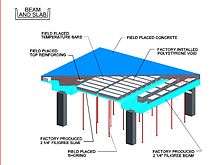Filigree concrete
The Filigree Wideslab method is a process for construction of concrete floor decks from two interconnected concrete placements, one precast in a factory, and the other done in the field. The method was developed during the late 1960s by Harry H. Wise as a more efficient and economic construction process than conventional cast-in-place technologies.[1]
Description

The process begins by manufacturing thin precast concrete panels, typically 2.25" thick, with the deck's bottom reinforcement included. The panels are then shipped to a jobsite and erected on temporary shoring. Subsequently, the deck's top reinforcing steel is placed on top of the precast panels at the site, and concrete is poured over the entire assembly to achieve the final thickness of the deck.
This process effectively accelerates the construction of structures by eliminating the need for costly and time-consuming field forming, and the placing of bottom reinforcement. Polystyrene blocks are often incorporated into the panels during their manufacture in order to create voids, reducing both the quantity and cost of concrete added in the field, and the overall weight of the structure, which further reduces the costs of columns and foundations.[2]
The soffits of the panels have a smooth uniform finish as a result of casting them in polished steel molds. This reduces the labor cost and time typically required to grind and patch the soffits of cast-in-place concrete decks to achieve an acceptable aesthetic finish.
The method of deck construction can be applied anywhere conventionally poured-in-place concrete is specified, such as flat plate, beam and slab, and wall-bearing structures.
Design methods
A concrete deck using the Filigree method of construction is designed using virtually the same techniques as are used for cast-in-place decks as prescribed by the American Concrete Institute document ACI318-11.[3] Specifically, Section 17, titled "Composite Concrete" permits the use of precast concrete elements to be attached to cast-in-place concrete provided the requirements of this section are adhered to.
The system is designed as a one-way continuous span slab supported on continuous span beams. An analysis of the slab take into account the width of the beams, as the deeper beams behave as slab haunches, proving greater stiffness to the slab near a support.
The top reinforcement design for the slabs should be done at both the beam center lines, and at the beam faces. This is because the negative slab moments are typically much less at a beam face, allowing a reduction in the top reinforcement required.
The beams are designed with a frame analysis that includes the stiffness of the columns. Punching shear stress is checked
Fire resistance
The heat variation of concrete deck surfaces during a fire may reach a level of 1500 °F. Under such conditions, the horizontal shear stress at the contact faces of the concrete layers becomes unpredictable, and may well exceed the values permitted by the code. This may consequentially cause separation of the layers and de-lamination the composite deck.
Since data is not available to reliably predict the behavior of a composite concrete decks during a building fire, a complete fire test is necessary to determine the structure's sustainability and safety.
The standards for such fire tests are given by the building code as "Standard Fire Tests of Building Construction and Materials UL263", ASTM E119, and NFPA, No. 251.
The International Building Code requires that only fire resistant components may be used for construction of publicly used structures. All pre-cast concrete elements used for floor construction carry a United Testing Laboratory Certified Fire Resistant Rating.
See also
References
- ↑ "Alternative Concrete", Construction-Today Magazine, March 2009, p.106
- ↑ http://www.filigreeinc.com
- ↑ "ACI Committee 318 (2011)". ACI 318-11: Building Code Requirements for Structural Concrete and Commentary. American Concrete Institute. ISBN 978-0-87031-744-6.